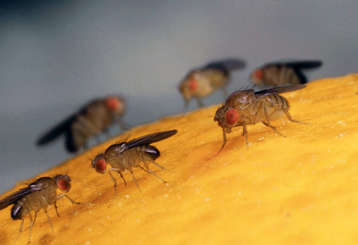Discovery: Studying Teenage Brains | Aggression Gene | Twitter Future Is What? | Fruit Fly Sex Research
/ Photograph by Kitra Cahana. CAUGHT IN THE MIRROR of her parents’ truck, 12th grader Amy “Dandilion” Olsen waits at a light in downtown Austin, Texas.The Teenage Brain National Geographic
Photograph by Kitra Cahana. CAUGHT IN THE MIRROR of her parents’ truck, 12th grader Amy “Dandilion” Olsen waits at a light in downtown Austin, Texas.The Teenage Brain National Geographic
A federal government sponsored NIH project studied the brain development of more than a hundred young people during the 1990s, determining that while the brain don’t grow physically much during ages 12 and 25, but do undergo a massive reorganization in those 13 years.
* Long nerve fibers called axons that signal other neurons become insulated, boosting transmission speed up to a hundred times.
* Dendrites grow twiggier, with synapses growing richer and stronger. Inactive snapses wither, in a form of brain pruning.
This process of maturation — previously thought to be finished by elementary school — continues not only throughout adolescence but into adulthood.
Stronger links also develop between the hippocampus, a sort of memory directory, and frontal areas that set goals and weigh different agendas; as a result, we get better at integrating memory and experience into our decisions. At the same time, the frontal areas develop greater speed and richer connections, allowing us to generate and weigh far more variables and agendas than before.
Making Twitter Relevant
Will Twitter Become Profitable? NY Magazine
Measured by the number of people who’ve joined the flock, Twitter’s growth is indeed staggering—a 370 percent surge in users since 2009. In fact, it resembles nothing so much as Google a decade ago, and everyone here, along with the small army of venture capitalists whose millions are funding this laboratory, is aware of this fact, as well as the implied competition with social-media superstars like Facebook and Zynga that are promising to go public and make lots of Valley V.C.’s very rich. Google has launched an assault with Google+, a more controlled social world, equidistant from Facebook and Twitter, and thus a possible refuge for those who are disaffected by Twitter’s chaotic news flow.
Presently Twitter has little context. Profits are the big challenge, but so is meaning and real relevance. Except as a broadcast channel for world events — allowing global citizens to jump over slow big media and repressive governments — Twitter’s real value is??
Wall Street may be worrying about profits. The technocrats of Twitter are focused on moving beyond international Tweets like this one from 27year-old Meghan McCain:
OHHH MY GOD—A BIG JIANT SPIDER JUST CRAWLED ON MY PILLOW!!!!!! ARGHHHH OMG OMG OMG EWWWW OMG!!!!!!!!!!!
Question is: who really cares! Better yet, why is Meghan McCain text relevant?
Discovery
Children find human-made objects more likely to be owned than natural objects Science Daily
Children as young as 3 are likely to say that things made by humans have owners, but that natural objects, such as pine cones and sea shells, are not owned, according to a new study published by the American Psychological Association.
Aggression-Boldness Gene Identified in Model Fish Science Daily
Researchers believe that aggressiveness in zebrafish is potentially tied to the action of a single gene (fgfr-1), which regulates histamine levels in the brain. We know that histamine is the neurotransmitter involved in numerous behavioral traits.
The combination of the three characteristics defining aggressive and bold behavior depends on the action of a single gene present in all vertebrates. Environmental factors (physico-chemistry, animal density, food supply, etc.) are also likely to have an influence on behavior, but the fgfr-1 gene seems to regulate the basic level of proactivity.
Study of Bees Links Gene Regulatory Networks in the Brain to Behavior Science Daily
 Fruity aromas: an aphrodisiac for flies CNRS
Fruity aromas: an aphrodisiac for flies CNRS
Described for the first time, the olfactory molecular receptor IR84a maintains the sensorial neurons permanently active, even without odor, so as to keep the male flies ready to attract a potential partner. In this way, the more “perfumed” (with phenylacetic acid) the partner, the more attractive it will be, thereby greatly increasing the insect’s sexual arousal.
Fruit fly research is often highly applicable to humans, given our large amount of shared DNA. More fruit fly; more aphrodisiac
‘Glow-in-the-dark’ Sperm Reveal Sexy Fruit Fly Secrets AOC News Musings

